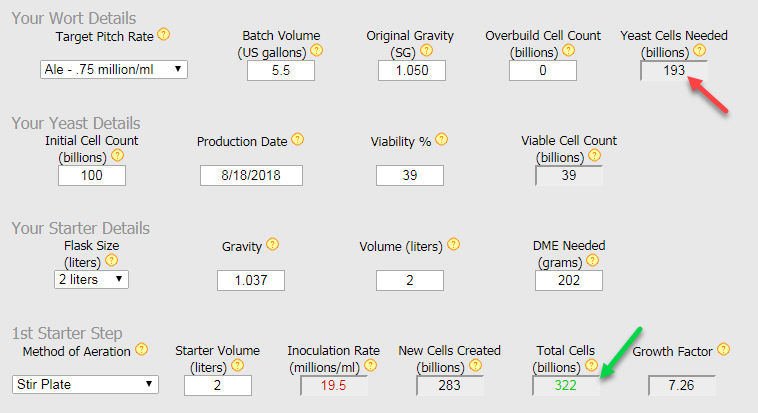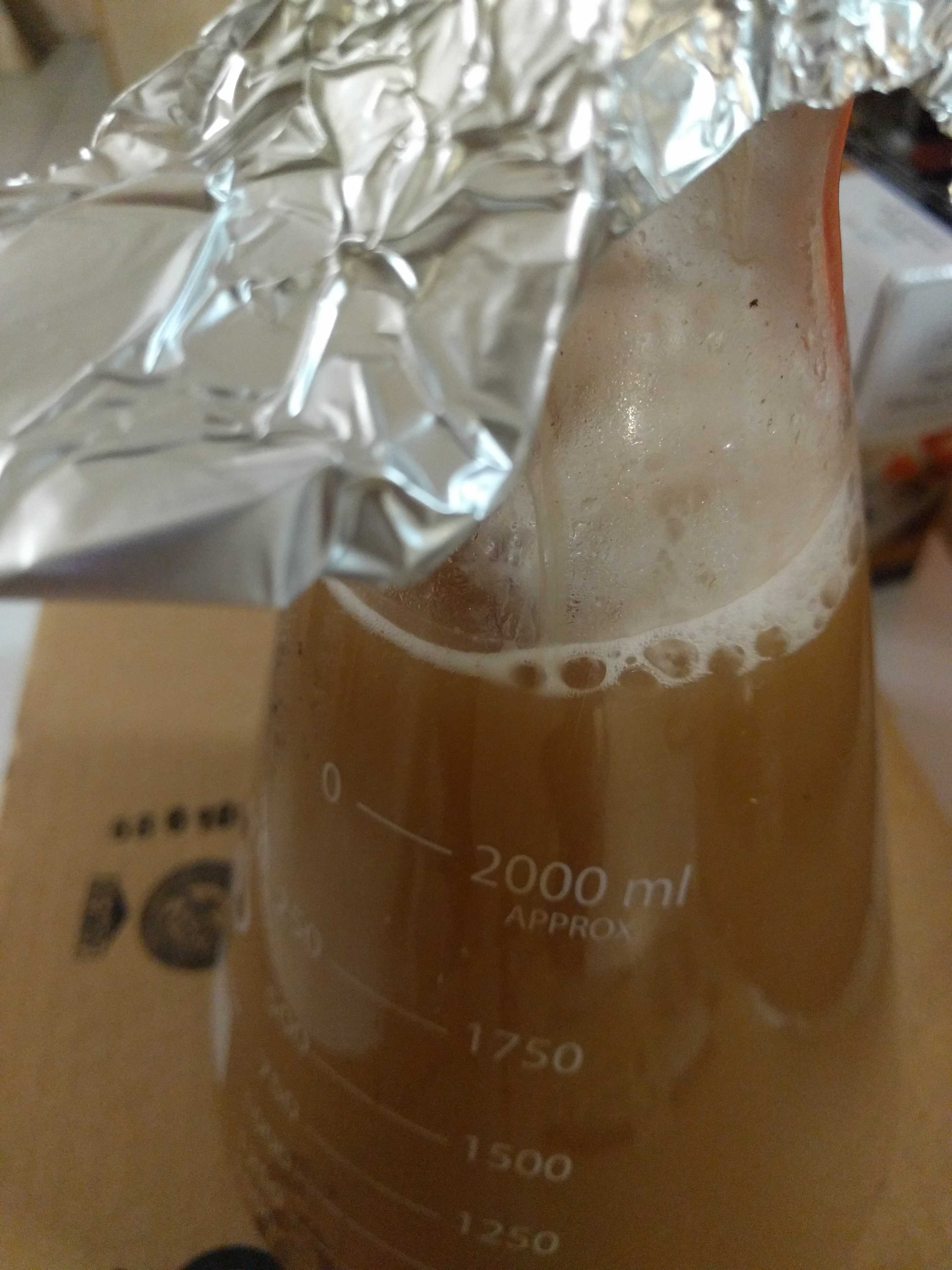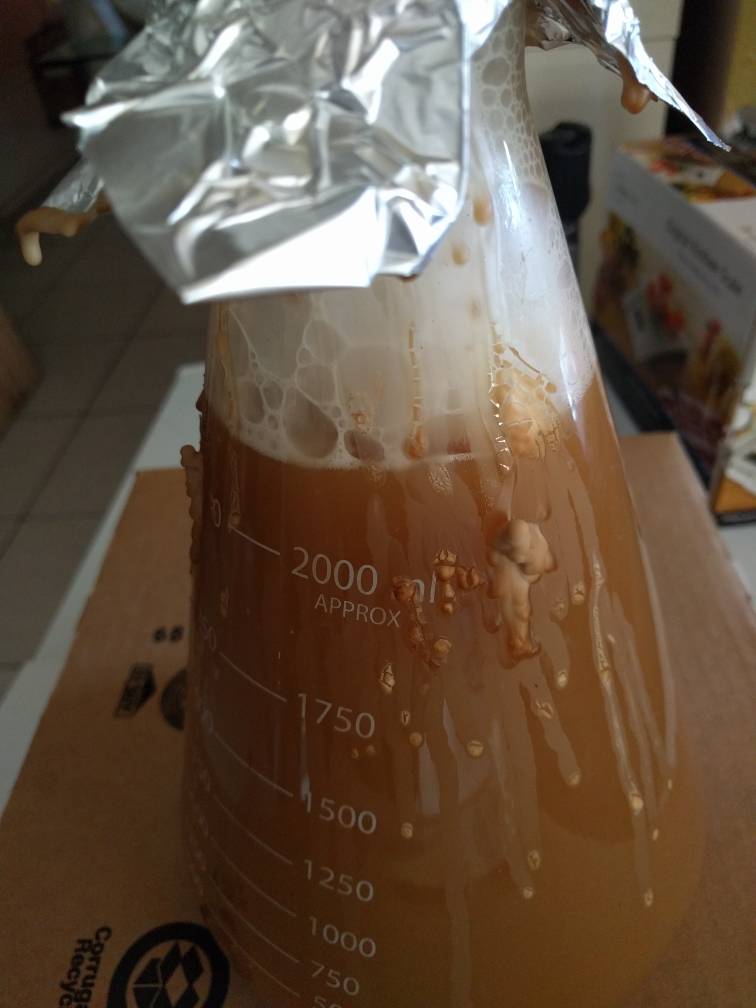You are using an out of date browser. It may not display this or other websites correctly.
You should upgrade or use an alternative browser.
You should upgrade or use an alternative browser.
Yeaster starter not doing anything
- Thread starter urg8rb8
- Start date

Help Support Homebrew Talk - Beer, Wine, Mead, & Cider Brewing Discussion Forum:
This site may earn a commission from merchant affiliate
links, including eBay, Amazon, and others.
I need to brew this Saturday. I'd have to order new yeast.Give it about 6 more hours, if you're in a time constraint or you don't see anything by then make a new one. I've had two do absolutely nothing and one that took way longer than all the rest.
What temp is it?
How old was the yeast? Any clearing of the color of the wort? At room temperature ~70 degrees? I wouldn't give up on it yet. But I would have a back up plan.
What yeast is it? I'd let it go for 18 hrs like the prev poster said. If still nothing, than I would get some more yeast and do it over.
Are you close enough to drive and get more or do you have to order online?
Are you close enough to drive and get more or do you have to order online?
BlueHouseBrewhaus
Well-Known Member
If the yeast was older, it can take a few more hours to kick in. I've had some ferment in just a few hours and the only evidence is that it takes on a creamy yellow color. Either way, 18-24 hours should do it. The only starter I ever had that took longer was one I started from Ommegang harvested dregs. That one took 36 hours.
Temp is at mid 70s.What temp is it?
It looks like it got lighter. I just smelled the solution and I think I smell alcohol. Hit absolutely no activity. The yeast expires in Feb.How old was the yeast? Any clearing of the color of the wort? At room temperature ~70 degrees? I wouldn't give up on it yet. But I would have a back up plan.
I'm using WLP400, Belgian Wit. There is a place near by but its hit or miss with their yeast stock.What yeast is it? I'd let it go for 18 hrs like the prev poster said. If still nothing, than I would get some more yeast and do it over.
Are you close enough to drive and get more or do you have to order online?
WBB
Grab me another beer please!
Do you have it on a stir plate or are you manually agitating it?
It's on a stir plate in an Erlenmeyer flask.Do you have it on a stir plate or are you manually agitating it?
Must be old or mishandled yeast.I need to brew this Saturday. I'd have to order new yeast.
Give it as long as 3-4 days on your stir plate. It's done 24 hours after it starts to turn much lighter and milky.
anotherbeerplease
Well-Known Member
I had some Bells dregs that took several days... they don't all take off right away...
I don't know what to say to help ,but that yeast is a beast . I have taken 250ml of saved slury from a starter that was 1 yr old and set it on the counter ,when it warmed up it started these little volcanoes popping up from the cake. From now on I decant right away. Knowing that about this yeast I would get a new sample.
I found that it erupted this morning!View attachment 603049
I was going to say something about that flask being way too full. Anything over about 1.8L always barfs out on me. Glad it took off.
Is that a blob of yeast on the outside of the flask?I was going to say something about that flask being way too full. Anything over about 1.8L always barfs out on me. Glad it took off.
Next time I'll make sure to add less water.
That's a whole different scenario, those are small amounts of old (and tired) yeast, not a "fresh" pack from a yeast lab. They do take a few rounds and time to grow into a pitchable amount.I had some Bells dregs that took several days... they don't all take off right away...
Yup, that was good yeast that got pushed out. There's another blob to the left of it, toward the back.Is that a blob of yeast on the outside of the flask?
Use less starter wort! You want a gravity of 1.037-1.040.Next time I'll make sure to add less water.
If you're preparing your starter wort in the flask, consider using a stainless cooking pot, with a good fitting lid, instead. It cools much faster in a sink or tub with cold water. It also won't crack from stress during heating.
Yeah, probably didn't lose much yeast.. hopefully.Yup, that was good yeast that got pushed out. There's another blob to the left of it, toward the back.
Use less starter wort! You want a gravity of 1.037-1.040.
If you're preparing your starter wort in the flask, consider using a stainless cooking pot, with a good fitting lid, instead. It cools much faster in a sink or tub with cold water. It also won't crack from stress during heating.
You now know it's working!Yeah, probably didn't lose much yeast.. hopefully.
Yes thankfully! I was about to call the place where I bought the yeast and start complaining! [emoji1]You now know it's working!
How long did it take to turn lighter and somewhat milky? A pack well within date (3 months old) should take off fast on a stir plate. Especially the WL Pure Pitch sleeves as they are supposed to retain around 90% viability during the first 3 months.Yes thankfully! I was about to call the place where I bought the yeast and start complaining! [emoji1]
Was this shipped to you? Maybe it got frozen somewhere en route; overheated can be mostly ruled out during this time of year, although not totally.
At least this proves to always make a starter well ahead of brew day, so plan B can be implemented without having to resort to whatever "generic" dry yeast is on hand.
It may still be worth checking with your supplier. That's a vigorous yeast usually.
I didn't really notice it getting lighter until after 24 hours. Yes it was shipped to me with an ice pack. I have a feeling that my fridge was on the colder side so maybe the yeast needed more time to wake up.How long did it take to turn lighter and somewhat milky? A pack well within date (3 months old) should take off fast on a stir plate. Especially the WL Pure Pitch sleeves as they are supposed to retain around 90% viability during the first 3 months.
Was this shipped to you? Maybe it got frozen somewhere en route; overheated can be mostly ruled out during this time of year, although not totally.
At least this proves to always make a starter well ahead of brew day, so plan B can be implemented without having to resort to whatever "generic" dry yeast is on hand.
It may still be worth checking with your supplier. That's a vigorous yeast usually.
Hopefully I have enough yeast even after losing some from the volcano action. I did 2L so I could split the yeast: half for Saturday brew, other half to store for future brews.
24 hours is not a long time, it may easily take 48 hours before enough cells are formed to give a significant lighter appearance. I've seen that many times. Yeast count can double every 90-120 minutes under optimal conditions, a stir plate or shaker at room temps and some nutrients (DAP/Urea/Magnesium/Zinc, etc.) help toward that goal.I didn't really notice it getting lighter until after 24 hours. Yes it was shipped to me with an ice pack. I have a feeling that my fridge was on the colder side so maybe the yeast needed more time to wake up.
It's important that yeast and wort are within 10°F of each other when pitching it. Within 5°F is even better. It prevents yeast shock and little mutants from forming.
Aren't you using a yeast calculator like HomebrewDad's to estimate the cell count to pitch?Hopefully I have enough yeast even after losing some from the volcano action. I did 2L so I could split the yeast: half for Saturday brew, other half to store for future brews.
The slurry from a 2 liter starter contains about the appropriate amount of cells. 1.5-1.8 liter starters can be fine too.
If you "overbuild" your starters somewhat (making it a bit larger than you need) you can save some out to make a starter from for next time, and so on. But definitely not half, maybe 100-200 ml worth. I put that extra in one or two 8 oz (~240 ml) mason/jelly jars. Or pour some of the crashed slurry into a 4 oz jelly jar and add a few ounces of the saved supernatant to it for storage. 50-100 billion cells saved out will make a perfect starter for next time, even 3-6 months later.
So I have a little over two liters for a starter. What I was planning to do was cold crash it then dump out enough beer to leave 32oz of beer in the flask. Then mix it all up to resuspend the yeast and pour 16oz of it into a pint jar to save for later and then pour the other 16 oz into the wort for fermentation.24 hours is not a long time, it may easily take 48 hours before enough cells are formed to give a significant lighter appearance. I've seen that many times. Yeast count can double every 90-120 minutes under optimal conditions, a stir plate or shaker at room temps and some nutrients (DAP/Urea/Magnesium/Zinc, etc.) help toward that goal.
It's important that yeast and wort are within 10°F of each other when pitching it. Within 5°F is even better. It prevents yeast shock and little mutants from forming.
Aren't you using a yeast calculator like HomebrewDad's to estimate the cell count to pitch?
The slurry from a 2 liter starter contains about the appropriate amount of cells. 1.5-1.8 liter starters can be fine too.
If you "overbuild" your starters somewhat (making it a bit larger than you need) you can save some out to make a starter from for next time, and so on. But definitely not half, maybe 100-200 ml worth. I put that extra in one or two 8 oz (~240 ml) mason/jelly jars. Or pour some of the crashed slurry into a 4 oz jelly jar and add a few ounces of the saved supernatant to it for storage. 50-100 billion cells saved out will make a perfect starter for next time, even 3-6 months later.
You're suggesting to split this starter into three? I'm sure I'm misunderstanding you.
Another thing. I no longer see bubbles going up the walls of the flask. Does this mean fermentation is done? Should I stop the stir plate?24 hours is not a long time, it may easily take 48 hours before enough cells are formed to give a significant lighter appearance. I've seen that many times. Yeast count can double every 90-120 minutes under optimal conditions, a stir plate or shaker at room temps and some nutrients (DAP/Urea/Magnesium/Zinc, etc.) help toward that goal.
It's important that yeast and wort are within 10°F of each other when pitching it. Within 5°F is even better. It prevents yeast shock and little mutants from forming.
Aren't you using a yeast calculator like HomebrewDad's to estimate the cell count to pitch?
The slurry from a 2 liter starter contains about the appropriate amount of cells. 1.5-1.8 liter starters can be fine too.
If you "overbuild" your starters somewhat (making it a bit larger than you need) you can save some out to make a starter from for next time, and so on. But definitely not half, maybe 100-200 ml worth. I put that extra in one or two 8 oz (~240 ml) mason/jelly jars. Or pour some of the crashed slurry into a 4 oz jelly jar and add a few ounces of the saved supernatant to it for storage. 50-100 billion cells saved out will make a perfect starter for next time, even 3-6 months later.
Sorry, I wasn't clear enough.So I have a little over two liters for a starter. What I was planning to do was cold crash it then dump out enough beer to leave 32oz of beer in the flask. Then mix it all up to resuspend the yeast and pour 16oz of it into a pint jar to save for later and then pour the other 16 oz into the wort for fermentation.
You're suggesting to split this starter into three? I'm sure I'm misunderstanding you.
Most likely you'll need more than half of your starter for that beer, it needs a yeast pitch of around 200 billion cells.
Production date is 6 months before "expiration" date, say August 18.The yeast expires in Feb.
Yeast starter estimate from Homebrew Dad's yeast calculator:

Your starter will have around 300 billion cells when all is done, not counting the unknown amount that flew the coup.
So you can save out 1/3 (~100 billion) and pitch 2/3 (~200 billion).
Process:
- Take the crashed starter out of the fridge when you start your brew day
- Decant most of the starter beer off the top, leaving enough behind to swirl into a pourable slurry (8-16 oz)
- I prefer to leave only 8-16 oz of starter beer to swirl up the slurry
- Make sure all the sticky cake on the bottom is in suspension
- Pour 1/3 into your (small) sanitized jar for next time, and put a label on it:
- WLP400 St.1. 12/19/18 100b
- St.1 = Starter #1; Harvest/Ranch date; 100b = ~100 billion cells (est.)
- Lid, and put back into fridge
- Cover the flask with the foil and let come to room temps while you brew
- ... brew your beer ...
- Oxygenate wort right before you pitch or right after
- Swirl the yeast up again before you pitch, being within 10°F (or 5°F) of the wort temp
You are awesome!!! Thank you very much for all of this detail!!!Sorry, I wasn't clear enough.
Most likely you'll need more than half of your starter for that beer, it needs a yeast pitch of around 200 billion cells.
Production date is 6 months before "expiration" date, say August 18.
Yeast starter estimate from Homebrew Dad's yeast calculator:
View attachment 603119
Your starter will have around 300 billion cells when all is done, not counting the unknown amount that flew the coup.
So you can save out 1/3 (~100 billion) and pitch 2/3 (~200 billion).
Process:
- Take the crashed starter out of the fridge when you start your brew day
- Decant most of the starter beer off the top, leaving enough behind to swirl into a pourable slurry (8-16 oz)
- I prefer to leave only 8-16 oz of starter beer to swirl up the slurry
- Make sure all the sticky cake on the bottom is in suspension
- Pour 1/3 in your (small) sanitized jar for next time, and put a label on it:
- WLP400 St.1. 12/19/18 100b
- St.1 = Starter #1; Harvest/Ranch date; 100b = ~100 billion cells (est.)
- Lid, and put back into fridge
- Cover the flask with the foil and let come to room temps while you brew
- ... brew your beer ...
- Oxygenate wort right before you pitch or right after
- Swirl the yeast up again before you pitch, being within 10°F (or 5°F) of the wort temp
Similar threads
- Replies
- 15
- Views
- 1K
- Replies
- 3
- Views
- 428
- Replies
- 19
- Views
- 585



